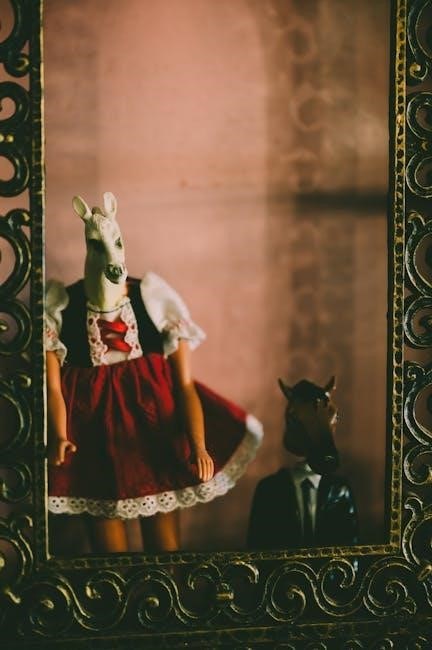
The Strange Case of Dr. Jekyll and Mr. Hyde, written by Robert Louis Stevenson, is a Gothic novella exploring the duality of human nature through contrasting characters.
1.1 Overview of “The Strange Case of Dr. Jekyll and Mr. Hyde”
Published in 1886, Robert Louis Stevenson’s Gothic novella explores the dual nature of humanity through Dr. Henry Jekyll and his dark alter ego, Mr. Edward Hyde. The story, set in Victorian London, delves into themes of morality, identity, and the struggle between good and evil. Jekyll’s experiment unleashes Hyde, embodying his suppressed desires, leading to a tragic confrontation. This classic tale has captivated readers with its psychological depth and remains a cornerstone of literary exploration into human duality.
1.2 Historical Context and Significance
Written in 1886, The Strange Case of Dr. Jekyll and Mr. Hyde reflects Victorian-era societal tensions, exploring themes of morality and the unconscious mind. Stevenson’s work emerged during a time of growing interest in psychology and the supernatural, resonating with readers’ fears of hidden vices. The novella’s enduring popularity lies in its universal exploration of human duality, transcending its historical context to remain a timeless commentary on the struggle between good and evil. Its influence spans literature, film, and popular culture, solidifying its place as a classic of Gothic fiction.
Plot Structure and Key Incidents
The novella follows lawyer Gabriel Utterson’s investigation into Dr. Jekyll’s mysterious connection to the sinister Mr. Hyde, uncovering a dark dual identity and tragic consequences.
2.1 Major Plot Points and Their Significance
The novella begins with Mr. Utterson investigating Dr. Jekyll’s mysterious will, which grants inheritance to the sinister Mr. Hyde. The murder of Sir Danvers Carew exposes Hyde’s evil nature, while Dr. Lanyon’s narrative reveals Jekyll’s transformation struggles. Jekyll’s disappearance and the discovery of his laboratory climax the story, leading to his tragic demise. These incidents underscore the duality of human nature and the devastating consequences of unchecked desires, central to Stevenson’s exploration of morality and identity. The plot’s suspenseful progression heightens the themes of good vs. evil.
2.2 Narrative Style and Storytelling Techniques
Stevenson employs a suspenseful, layered narrative style, revealing the story through multiple perspectives, including letters, diaries, and eyewitness accounts. This epistolary format builds mystery and engages readers by gradually uncovering the truth. The use of symbolism, such as the door separating Jekyll and Hyde, emphasizes the duality of human nature. The Victorian setting and Gothic tone enhance the eerie atmosphere, while the narrative’s non-linear progression heightens tension. These techniques masterfully explore the novella’s themes of morality and identity, leaving a lasting impact on readers.

Major Characters in the Novella
Dr. Jekyll and Mr. Hyde represent the dual nature of humanity, with Jekyll embodying respectability and Hyde symbolizing unchecked evil. Mr. Utterson, a lawyer, investigates their connection, while Dr. Lanyon and Mr. Enfield provide pivotal insights into the mystery.
3.1 The Dual Nature of Dr. Jekyll and Mr. Hyde
Dr. Jekyll, a respected scientist, and Mr. Hyde, a monstrous figure, embody the contrasting aspects of human nature. Jekyll’s desire to separate his moral and immoral selves leads to the creation of Hyde, who symbolizes unchecked evil. While Jekyll represents civilization and restraint, Hyde embodies primal instincts and chaos. Their duality explores the internal struggle between good and evil, with Jekyll’s experiments revealing the darker aspects of his personality. This psychological conflict ultimately leads to tragic consequences, highlighting the destructive potential of unchecked desires.
3.2 Significant Supporting Characters and Their Roles
Mr. Utterson, a lawyer and Jekyll’s friend, drives the narrative by investigating Hyde’s mysterious influence. Dr; Lanyon, Jekyll’s colleague, provides critical insights into Jekyll’s transformation. Poole, Jekyll’s loyal butler, witnesses the novella’s climax. These characters reveal the societal implications of Jekyll’s experiments and the fear Hyde instills. Their roles highlight the novella’s themes of morality and identity, enriching the exploration of Jekyll and Hyde’s dual nature.
Themes and Motifs Explored
The novella explores the duality of human nature, morality, and identity, presenting a haunting struggle between good and evil through Jekyll’s transformation into Hyde.
4.1 The Duality of Human Nature
The novella masterfully portrays the duality of human nature through Dr. Jekyll and Mr. Hyde, symbolizing the internal conflict between good and evil. Jekyll, a respected scientist, struggles with his darker impulses, which he personifies as Hyde. This duality is central to the story, exploring how individuals can harbor opposing forces within themselves. Stevenson uses this contrast to highlight the moral and psychological complexities of human beings, making it a timeless theme that resonates with readers universally. The struggle between Jekyll’s civilized demeanor and Hyde’s primitive instincts underscores the delicate balance between light and darkness within every person.
4.2 Symbols and Their Representation in the Story
The novella is rich in symbolism, with key elements representing deeper themes. The door to Dr. Jekyll’s laboratory symbolizes the divide between his public and private selves, while the potion represents the transformative power of science and morality. London’s fog mirrors the moral ambiguity and hidden evils in society. These symbols underscore the struggle between good and evil, highlighting the duality of human nature and the consequences of unchecked ambition. They enrich the narrative, offering layers of meaning that resonate with readers.

Availability and Download Options
The novella is freely available as a PDF from sources like Project Gutenberg and Google Books, with licensed versions offered by publishers like Riverglen Press.
5.1 Sources for Free PDF Downloads
The Strange Case of Dr. Jekyll and Mr. Hyde is widely available as a free PDF due to its public domain status. Sources like Project Gutenberg, Google Books, and ManyBooks offer direct downloads. These platforms provide high-quality, digitized versions of the novella, often with introductions and illustrations. Additionally, websites such as Archive.org and Librivox host free PDFs, making it accessible to readers worldwide. These versions are ideal for educational purposes or personal reading, ensuring the classic tale remains freely accessible to everyone.
5.2 Licensed Versions and Their Features
Licensed versions of The Strange Case of Dr. Jekyll and Mr. Hyde offer enhanced features for readers. For instance, editions from publishers like Riverglen Press include introductions and are formatted for readability. Planet eBook provides a professionally formatted version with a foreword, available in EPUB and MOBI formats. These licensed editions often include additional commentary, ensuring a richer reading experience. They are ideal for educators and enthusiasts seeking a more polished and structured presentation of the novella.

Adaptations and Interpretations
The novella has inspired numerous adaptations, including films, stage plays, and literary reinterpretations, showcasing its timeless appeal and versatility across different mediums and cultures.
6.1 Film, Stage, and Literary Adaptations
The Strange Case of Dr. Jekyll and Mr. Hyde has been widely adapted across various mediums. Notable film adaptations include the 1931 version starring Fredric March and the 2008 film “Jekyll” with James Nesbitt. On stage, it has been reimagined in numerous plays, such as the 2014 adaptation by David Edgar. Literary reinterpretations, like “The League of Extraordinary Gentlemen” by Alan Moore and Kevin O’Neill, further highlight its enduring influence. These adaptations showcase the novella’s versatility and its ability to captivate audiences through diverse storytelling approaches, ensuring its relevance across generations.
6.2 Pop Culture References and Influence
The Strange Case of Dr. Jekyll and Mr. Hyde has deeply influenced pop culture, inspiring countless references in film, literature, and music. The duality of Jekyll and Hyde is a recurring theme in works like “The League of Extraordinary Gentlemen” and “Penny Dreadful.” The novella’s iconic characters have also been referenced in songs by artists such as Lana Del Rey and The Rolling Stones. Its timeless exploration of human duality continues to resonate, making it a timeless influence in modern storytelling and cultural discourse.

Critical Analysis and Impact
The novella is acclaimed for its profound exploration of human duality, earning it a lasting place in Gothic literature and sparking enduring psychological and philosophical discussions.
7.1 Literary Impact and Reception
The Strange Case of Dr. Jekyll and Mr. Hyde is widely regarded as a masterpiece of Gothic literature, first published in 1886 to immediate acclaim. Its exploration of dual identity resonated deeply, sparking debates on morality and psychology. Victorian readers were captivated by its dark themes, and the novella quickly became a cultural phenomenon; Stevenson’s vivid storytelling and symbolic depth ensured its enduring influence, solidifying its place as a timeless classic in world literature.
7.2 Cultural Influence and Legacy
The Strange Case of Dr. Jekyll and Mr. Hyde has left an indelible mark on popular culture. Its themes of dual identity have inspired countless adaptations, from films to stage plays, cementing its legacy. The novella’s influence extends beyond literature, shaping psychological concepts and cultural references. The iconic characters of Jekyll and Hyde symbolize the internal struggle between good and evil, making them universally recognizable. Stevenson’s work remains a cornerstone of Gothic storytelling, continuing to captivate audiences and inspire new interpretations across generations.
Leave a Reply
You must be logged in to post a comment.